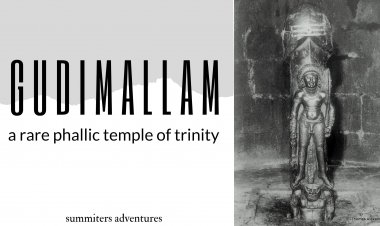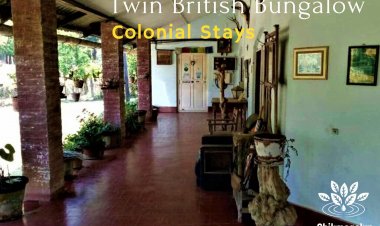Reliving Past At Hasta Shilpa Village, Manipal
Leaving behind the temple city Udupi and the coastal capital city Mangalore. There is much more on the list to offer the history buffs in Manipal known for its educational institutes. The Hasta Shilpa Heritage Village is an open museum comprising of Heritage vernacular structures and collectives for those who love history and art. A visit to Hasta Shilpa village will amaze you. It is not an amusement park or a picnic spot. It is purely an academic institution, run by a trust with absolutely no commercial activities If you are planning a coastal trip in near future. Don't forget to include this place it in the Itinerary.
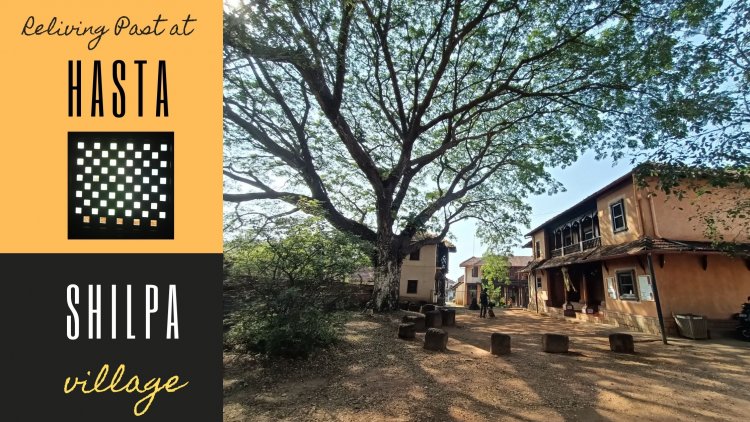
An imposing structure with the play of light and shadow drives me into the foyer of Miyar's house. As I step in, a world of unimaginable paraphernalia relating to heritage and architecture greets me. A stunning unique place unheard and unseen awaits you while visiting the coastal cities of Mangalore and Udupi. Both the place and visit came as a blessing in disguise to me during my visit to the coastal capital of Karnataka. A place to visit for those who have a keen interest or for connoisseurs of art with little curiosity to mesmerize you. I assure you, you will be totally contented. A pictorial journey clockwise to ignite a spark of interest in you to visit the place. You need to be physically present at the site to experience and travel in time !.
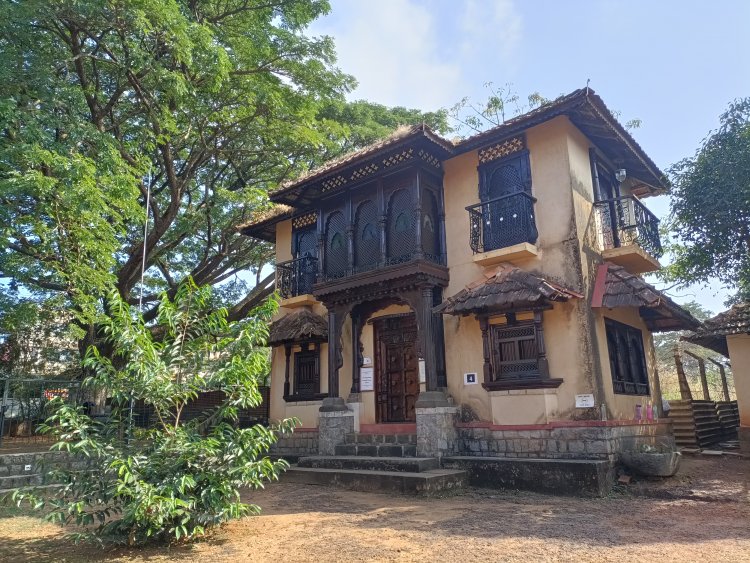
Peshwa Wada – Maratha architecture. This structure was relocated from the Belgaum district. This house can be viewed only from the outside.
I am in dilemma about whether it is a museum or an art gallery. Aptly captioned “Hasta” is hand in Sanskrit, “Shilpa” is a craft, and this museum lives up to its name. Spread over six acres, this museum popularly known as Hasta Shilpa Heritage Village contains reconstructed houses and shrines that span several centuries. And yes, these structures are characterized by intricate craftsmanship - A true work of love & labor.
A vision of a banker turned conservationist and his efforts to bring together the vanishing vernacular heritage structures in a complex, preserving them and in the meanwhile restoring them in their original glory. An achievement beyond words!
The heritage village is comprised of 3 different types of exhibits. Heritage houses, a few shrines, and a couple of lanes that recreate shops and businesses. The museum itself is an eclectic collection of art and handicrafts, artifacts from across India, including a museum dedicated to Bastar tribal art. Bastar is a district in Chhattisgarh state in Central India.
The structures here have stories to remind us of bygone eras. A collection of artifacts, clocks, household furniture, utensils, Soda bottles, sewing machines, glass bottles, bicycles, ceramic utensils, porcelain crockeries, footwear, locks and keys, canon and balls, Telephones, wall paintings, Measuring units, Vintage cars, mud pots and Terracotta containers, Chandeliers, Radio and Transistor, Decorative hanging colorful lamps, Musical instruments, Colourful Bangles, kerosene lamps and many more.
Everything has occupied a place here and you can see them in the open gallery in the vast enclosure.

I was eager to meet Mr Ramey Mallya, the charge of the museum. He began to speak incessantly about the exhibits and structures. The hot wave and humidity persuaded me to gulp a cup of water from a mud pot in one of the corners. I began on a self-guided tour following the signage. After the tour of Karkala, the heritage tour continues visiting the structures at 11 am after paying camera fee and buying an entry ticket...
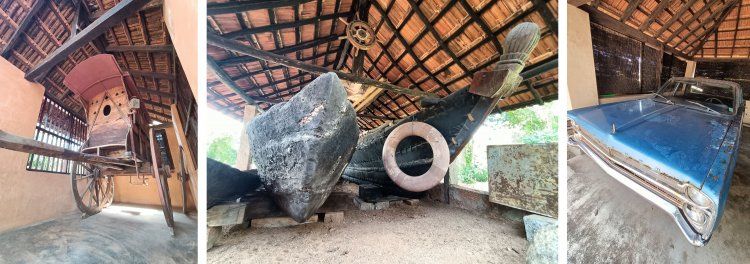
I could see, students moving around from one structure to another. A signage, at every structure, with names, descriptions, and directing our movements ( Leave your footwear outside, Don't litter, Don't touch the artifacts, Don't Deface walls, Maintain silence) is a laudable work.
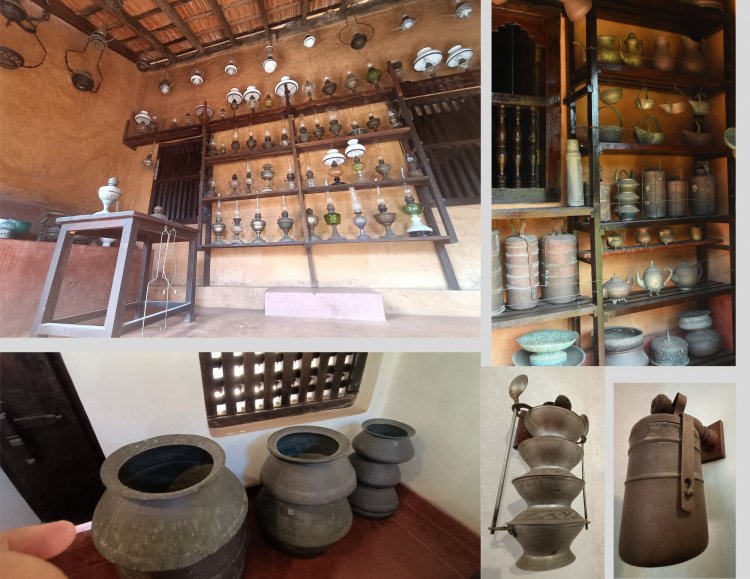
Located in the heart of Manipal, popularly known as University Town is just a stone's throw from the temple town of Udupi. The Hast Shipa Heritage Village Museum is the dream of Mr. Vijaynath Shenoy one person's brainchild who was passionate about collectives. Having restored decrepit traditional homes to their former glory at a heritage village in Manipal. His dream has been realized in the form of a heritage Village today, which is managed by a group of passionate like-minded people.
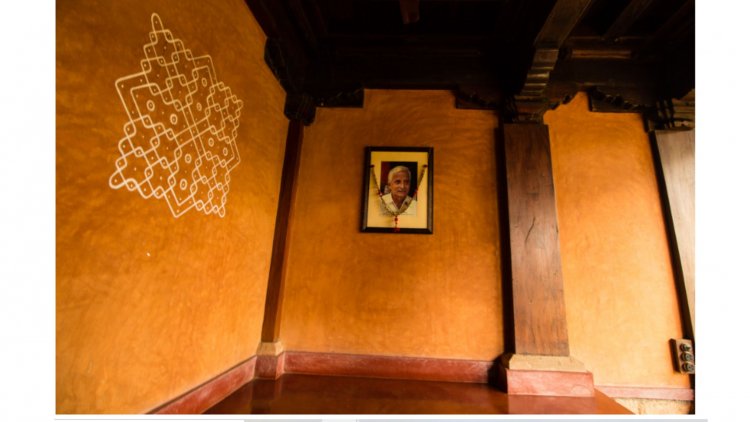
Photo of Visionary Mr Vijaynath Shenoy at The Miyar House, which is a typical Hebbagilu Chavadi structure, dating to the 19th century, with lovely balconies in its upper storey. It serves as the entrance to a heritage village.
Mudhol Palace Durbar Hall
Home of the Ghorpades. The 19th-century marvel was transported all the way from Bagalkot district to Manipal and reerected to its original glory by the team at Hasta Shilpa Heritage Village. The royal durbar of the Raja of Mudhol is a delightful blend of Maratha and Rajasthani styles of architecture. The rich teakwood work is offset by the vibrant colors of vegetable dye on the ceilings and the window panes. The most striking feature of this set-up is the intricately carved doors – especially the one at the entrance.
Don’t miss the water trough known as kallina dhone at the entrance, for the visitors used to clean their feet before entering the house. And yes, don't miss to see those lovely artistic palanquins kept on display within the house.
Last and least Mudhol, is also known as a breed of dog, Mudhol hound or Caravan Hound. They are known for their hunting and guarding skills even today. The characteristically lanky Mudhol hounds get their name from the erstwhile kingdom of Mudhol (in present-day Bagalkot), whose rulers first began to breed them.
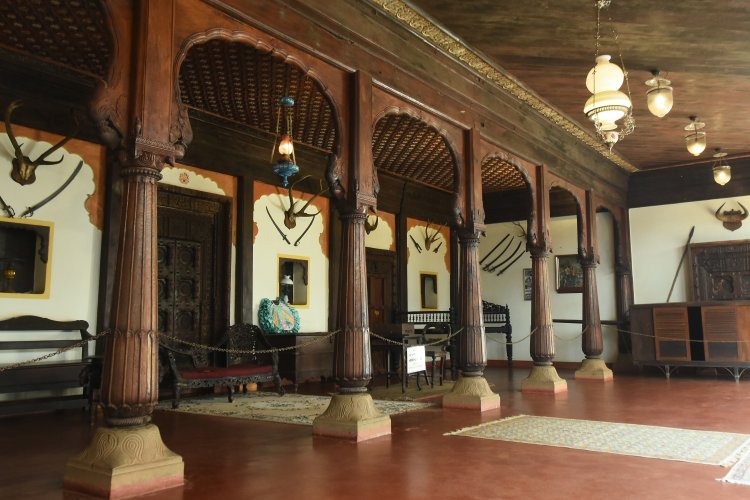
Mudhol Palace Durbar Hall circa 1816. The king held his durbar (audience) in this hall
Deccan Nawabi Mahal
I assume that I am looking into an oscilloscope, as I gain entry into Durbar Hall with the rhythmic slow Hindustani classical music. It is said to the Barid Shahi dynasty of Humnabad, the Deccan Nawabi Mahal reflects the grand lifestyle of the wealthy Nawabs. It reminded me of Mahal in Bara Imambara of Lucknow. It was clear that kings appreciated beautiful things and were they loved everything dear to their hearts and desired to get it.
Starting with the Belgian Colorful glass windows to the German tiles, Colourful chandeliers, and the British iron staircase, the hall clearly symbolizes the affluent connection and taste of Nawabs.
The central space was used as a stage for various performances – largely attended by male folk. The first floor has lattice windows through which the women would observe the proceedings below wearing a burqa without being seen by the outer world. Mr. Shenoy’s collection of Bidri ware, intricate work ( From Bidar )on metal finds a place around the room.
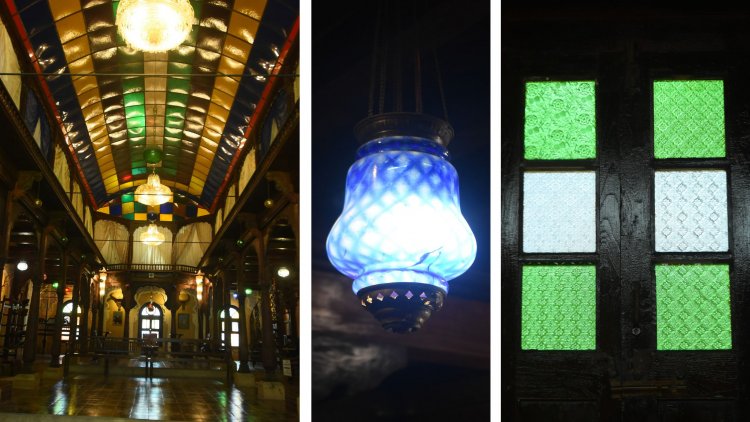
Harkur Olagina Mane
Harkur Olagina Mane: The house comprises a simple rectangle with a central court with broader rooms on its sides narrow rooms at the rear and a pillared verandah at the entrance. The Trust approached the family of Jeevan Shetty, owner of this manor. Funded by the Norwegian embassy, the trust acquired this structure, dismantled it, and restored it in its original form.
Likewise, the trust has restored the Sringeri house, Vaderhobli house, Byndoor Nelyadi house, Mangalore Christian house, Yerukone house, Hengavali-Korra house, Bhatkal Muslim house, Puchchamogaru Jungam Mutt, and Vidyamandira. The trust has also transplanted the Kamal Mahal of Kukanoor, the Deccani Nawab Mahal, and the Mudhol Palace Durbar Hall in their original forms.
Folk art galleries and museums are also part of the heritage village in Manipal.
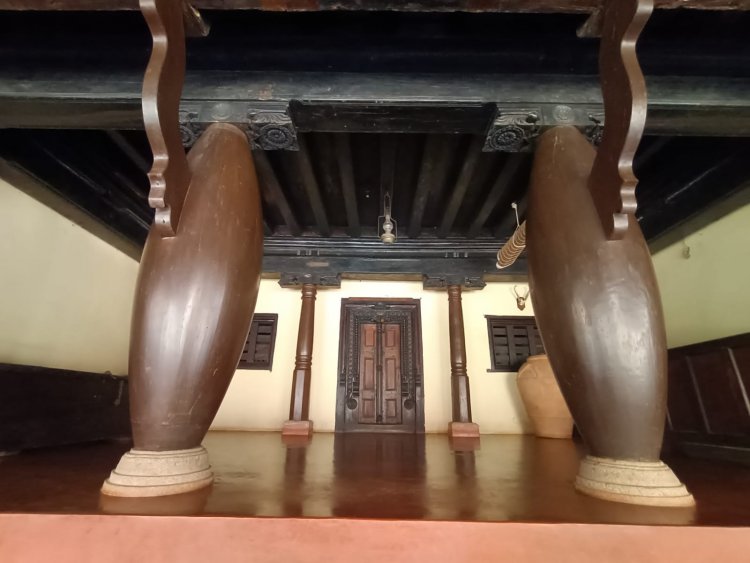
An external view of one of the restored houses, the Harkur Olagina Mane (Hasta Shilpa Heritage Village Trust)
Be it wooden, metal structures, or mud house architecture, each aspect with details. The relocated, and restored structures are impressive and are truly elegant. For the onlooker, it's a treat to eyes and simply soothing.
Some tips during a visit to Hasta Shilpa Heritage Village
- 1. For senior citizens, special battery-operated vehicles are available on the premises.
- 2. Restrooms, trash bins, and Drinking water in earthen pots are available.
- 3. While entering these houses, you must remove your shoes, so wear comfortable footwear, preferably flip-on.
- 4. A common hall is available for groups to have lunch. Contact the office before you enter it. Don't litter the premises.
- 5. No food is available inside the premises.
- 6. Tourists can avail of their entry tickets online, and if they carry a camera, they have to pay a separate charge
- 7. Guides are available for heritage tours. Contact the office for details
For more details visit https://www.heritagevillagemanipal.org/
Humble Request by Trust
Please support work through a new scheme developed for discerning people. Adopt a Heritage Structure and help the trust to keep these architectural centurions happy and safe!








